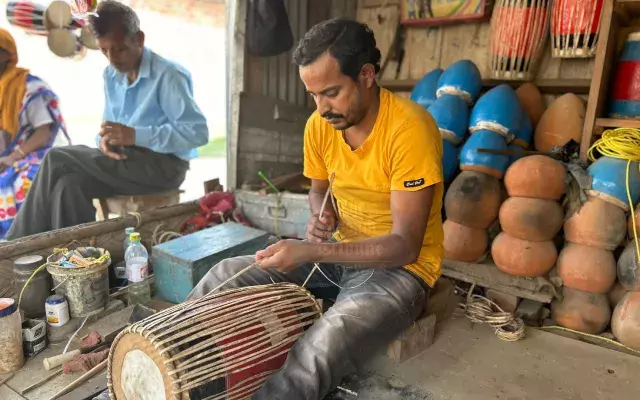
Guwahati, April 8: ‘Ghen shak jhum shak jhum pisa mirisak'—As the rhythmic beats of the dhol echo across Assam, it's nearly impossible to resist the urge to dance along. With the arrival of spring comes the vibrant celebration of Rongali or Bohag Bihu, eagerly awaited by the people of Assam. From the energetic performances of husori dols to the joyous participation of all ages, the festival is embraced with boundless enthusiasm.
Adding to the jubilation, the Ministry of Commerce and Industry, Government of India, bestowed the prestigious Geographical Indication (GI) tag upon the Assamese dhol on March 30, 2024. This announcement felt like a gift of Bihuwan, enhancing the festive spirit as communities prepare to revel in the festivities of Rongali Bihu.
As the state rejoices at the moment, the small-scale dhol manufacturers share their ordeal of how difficult it is to make a livelihood as well as keep the traditional craft alive.
Searching for a small-scale dhol maker, The Assam Tribune reached Muktapur, 11 km from Baihata Chariali, to learn about the challenges Haren Badyakar faced while keeping the traditional craft, started by his father in the late 1980s, alive.
“My father started making dhol in the late 1980s in this area, and since then we have carried forward this craft. Made of wooden barrels covered with animal skin (cow or goat skin), we sell the highest, though not in huge quantity, during Bohag Bihu. Last year, we sold around 40 dhols,” Haren said. “The process of making one dhol takes at least three to four days," he added.
Speaking on the hardships, Haren asserted, “People flock to my shop only during Bihu season, so I try to sell as much as possible to make a living until the next festive season as I do not have any other income source.”
“We tried to approach the state government through several appeals for any form of assistance, however, we are still left unheard,” he said.
The dhol maker expressed his optimism that, with the musical instrument securing the GI tag, the state government would take the necessary steps to uplift the small-scale dhol makers.
Meanwhile, speaking on the youths’ eagerness to learn the traditional art, one dhol artist in the area said, “During this festive season, several young girls approach me to learn Bihu dance, however, on the other hand, only a few boys show up to learn how to play the Bihu dhol. The reason, in my opinion, is that the youths engage more in studies to earn good money to run their families, or negative peer pressure might also be considered as one of the reasons.”
However, the scenes in the city are quite different than those in the village areas, as the guardians feel the need to keep the culture of Assam alive amidst the hustle and bustle of city life.
A professional dhol artist who teaches the art all year long in Guwahati city, Rantu Saikia, said that the number of boys trying to learn the traditional form is increasing every year. Saikia said, “Over the years, the number of boys willing to learn dhol badan has increased. The youths, who have the zeal to learn, are not limited to only the Assamese community.”
The contrasting differences between city and village areas call for an urgent need to adapt measures to keep the traditional art and culture of Assam alive for future generations.
